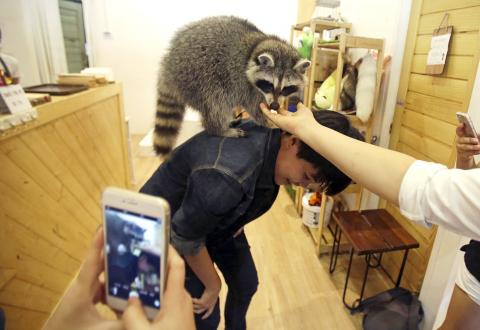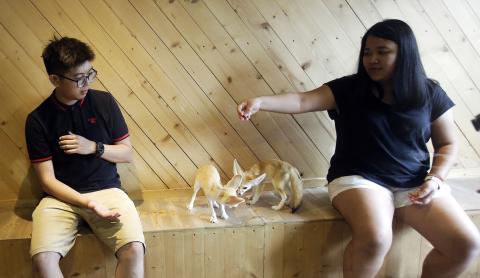Cat cafes where customers sip lattes while petting resident kitties are just opening their doors around the US and Europe. But in Asia, where the first one opened more than a decade ago, the concept has moved well beyond felines.
At Tokyo’s Snake Center, visitors pay 1,100 yen (about US$11) for a cup of coffee and a slithery friend to wind around their arm; a plate of curry bread snacks or a really big snake costs extra.
At We Are The Furballs (WTF) in Singapore, Mochi and her puppy pals yap at ankles and occupy guests’ laps for peaceful dognaps.

Photo: AP
EXOTIC PET REALITY CHECK
And at Little Zoo Cafe in Bangkok, meerkats, raccoons and little foxes with the softest ears imaginable can be cuddled near plates of crepes and French fries.
Some sell the animals, or offer them for adoption. Others invite customers to bring their pets, or just offer encounters with creatures — from penguins to hedgehogs.

Photo: AP
“I wanted there to be a place where people can come learn about the animals,” said Wachiraporn Arampibulphol, who opened an exotic animal cafe in Bangkok a year ago after visiting an owl cafe in Tokyo.
Snuggling Jelly, a blond fox, Wachiraporn said she used to import chinchillas, meerkats and other exotic pets, but worried that owners bought them impulsively and then abused them or let them collapse and die in Thailand’s heat.
She said customers at her Little Zoo Cafe get a reality check when they’re so close to the animals; she’s only sold a half dozen this year.
“When you see pictures and photos of these animals, you see their cuteness,” she said. “But people don’t think about what the animal would smell like or how actually raising one would be.”
Indeed, a musky odor floated above two red foxes — Mocha and Cappuccino — as they boisterously wrestled and skittered around customers’ legs.
Nearby, Nuttida Chaloembun, 23, from Bangkok, watched a waitress grapple with Cracker, a 25-pound raccoon, who chattered and swatted her away with little hand-like paws.
“It’s fat and really adorable but it won’t let me touch it,” laughed Nuttida.
Shirley Chaifong came to the Little Zoo Cafe all the way from Malaysia after seeing photos of meerkats on Instagram. But it was the tail-wagging corgi, an uncommon breed in Asia, she fell for.
“It’s a great way to see the animals,” she said, her hands running through his fur.
After a cat cafe opened in the San Francisco Bay Area in 2014 the concept quickly spread to more than 20 American cities, from New York to Los Angeles, and many more are planned. They’re also popular in Europe, with recent openings in Netherlands, Finland and Italy.
CAT CAFES
The Cat Flower Cafe in Taipei, Taiwan, took credit as the first-ever cat cafe when it opened in 1998, although some aficionados say cats meandered through a Viennese cafe almost a century earlier. The real boom began in 2005 in Japan, where few apartments allow pets. There are now more than 100 cat cafes listed in Japan, 50 in Tokyo alone. But new goat, rabbit and bird-themed eateries now offer competition.
American and European cat cafes have stringent health and safety regulations that sometimes ban actually petting animals, or require cats to remain well separated from food. Most are affiliated with local humane societies or rescue shelters. In many Asian countries, where there are fewer hygiene rules in restaurants and pets can be bought in street markets, animal rights activists say the cafes are cruel.
“These animals often become despondent and develop neurotic and self-destructive behavior,” said Jason Baker at People for the Ethical Treatment of Animals’ international campaigns office. “I don’t know why anyone would want to eat a meal surrounded by animals who are imprisoned in cages and pens that are tiny fractions of the size of their homes in the wild.”
But cafe owners say they’re trying to help the animals by allowing people to safely and compassionately interact.
Tokyo Snake Center cafe manager Hisamitsu Kaneko said visitors can gain new appreciation of their oft-maligned reptiles.
“People have biases, or preconceptions about snakes, that they’re disgusting or scary,” said Kaneko, whose customers choose from about 60 snakes. “I think there are no animals as beautiful.”
At Bangkok’s TrueLove (at) Neverland cafe, more than a dozen imported and bred huskies were panting — if calm — as they lounged for an hour outside on a humid 35-degree Celsius day, chewing ice cubes and carrots while visitors marveled at their thick fur.
At the end of a one-hour dog encounter, customers peeled off plastic foot covers, sanitized their hands, checked their husky-selfies and climbed into waiting tuk-tuk rickshaws. Barking and yipping, the dogs dashed en masse into their air-conditioned quarters to rest up and eat before their next human visitors.

On April 26, The Lancet published a letter from two doctors at Taichung-based China Medical University Hospital (CMUH) warning that “Taiwan’s Health Care System is on the Brink of Collapse.” The authors said that “Years of policy inaction and mismanagement of resources have led to the National Health Insurance system operating under unsustainable conditions.” The pushback was immediate. Errors in the paper were quickly identified and publicized, to discredit the authors (the hospital apologized). CNA reported that CMUH said the letter described Taiwan in 2021 as having 62 nurses per 10,000 people, when the correct number was 78 nurses per 10,000

As Donald Trump’s executive order in March led to the shuttering of Voice of America (VOA) — the global broadcaster whose roots date back to the fight against Nazi propaganda — he quickly attracted support from figures not used to aligning themselves with any US administration. Trump had ordered the US Agency for Global Media, the federal agency that funds VOA and other groups promoting independent journalism overseas, to be “eliminated to the maximum extent consistent with applicable law.” The decision suddenly halted programming in 49 languages to more than 425 million people. In Moscow, Margarita Simonyan, the hardline editor-in-chief of the

Six weeks before I embarked on a research mission in Kyoto, I was sitting alone at a bar counter in Melbourne. Next to me, a woman was bragging loudly to a friend: She, too, was heading to Kyoto, I quickly discerned. Except her trip was in four months. And she’d just pulled an all-nighter booking restaurant reservations. As I snooped on the conversation, I broke out in a sweat, panicking because I’d yet to secure a single table. Then I remembered: Eating well in Japan is absolutely not something to lose sleep over. It’s true that the best-known institutions book up faster

Though the total area of Penghu isn’t that large, exploring all of it — including its numerous outlying islands — could easily take a couple of weeks. The most remote township accessible by road from Magong City (馬公市) is Siyu (西嶼鄉), and this place alone deserves at least two days to fully appreciate. Whether it’s beaches, architecture, museums, snacks, sunrises or sunsets that attract you, Siyu has something for everyone. Though only 5km from Magong by sea, no ferry service currently exists and it must be reached by a long circuitous route around the main island of Penghu, with the